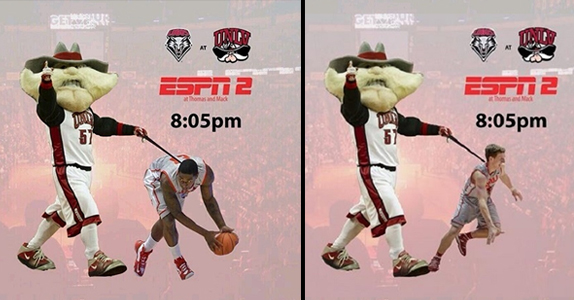
Dear Lobo Fans,
This week the Lobos won two big games, and their commanding play deserves a column. Unfortunately, other issues need our attention.
As you may know, two controversial images “promoting” the Lobo game at UNLV were tweeted by a self-proclaimed UNLV fan this week. Both images show Hey Reb, the UNLV mascot, holding a leash attached to a Lobo player: one a hunched Jamal Fenton, the other a running Cameron Bairstow. The photos turn my stomach. They are disgusting, sad, and hateful.
As the internet gives a platform to anyone with access, instances of hate will continue to exist in public forums. The photos could be chalked up to one person who published sick images, but the palpable response does not offer such clarity. On fan message boards and newspaper comment sections, individuals express their disapproval of the criticism around the images. One person wrote, “IT HAS NOTHING TO DO WITH RACE! GET OVER IT ALREADY!!” Another posted, “‘The Dogs’.. get it? UNM are the LOBOS (wolf in spanish). This has nothing to do with race or prejudice. Its 2014 people–get over the racism already! All of you are being way hyper-sensitive.”
The second image of Bairstow was picked up by the Rebellion, UNLV’s student section, and shared on its Instagram account. While both images have since been deleted from social media sites, they continue to receive both support and disapproval--not the definite censure they deserved.
This story is about more than one person producing demeaning content. After being picked up by Black Sports Online, both the Journal and the Las Vegas Journal-Review ran stories on the images, and, while many are talking about it, no proper authority has denounced these actions. The condemnation of these images must come from the institutions involved--UNLV, UNM, the Mountain West Conference, and the NCAA. As I wrote last week, universities and intercollegiate agencies have a responsibility to support and protect student athletes. As public institutions educating young people, the universities uphold cultural values, so, in situations such as this one, they must also teach why these images are hurtful and demeaning.
Since the uproar on Tuesday, UNM has been mum. To the best of my research, the University has not released an official statement on the situation. Only KRQE reported that UNM Dean of Student Tomas Aguirre said, “It is interesting that the original image was taken down.” That’s all. The Lobo Lair’s thread on the topic is far more definitive on the racism and ugliness of the images than UNM’s little-to-no response.
On Friday, UNM’s Ticketing Services sent an email addressed to season ticket holders asking fans “to be loud, be respectful and have fun.” It also includes a pledge containing “the ideals...students, staff and faculty aspire to everyday;” it reads: “Lead with courage and integrity/ Open my mind to diversity/ Be kind, respectful and civil/ Own my future and pursue excellence/ Serve in my community.”
Because an email similar to this one is rarely, if ever, sent, I assume a special reason exists behind it. If this email is in response to the media attention the images garnered, Ticket Services’ message avoids the true issue. If the email responds to observations of crowd behavior in The Pit, it needs to clearly state what the problem is, even if it is in general terms. If the email responds to a fear that the crowd may grow ugly during the sold-out SDSU game, the message needs to state the parameters which will not be tolerated--in this case, racism, violence, and inhumane treatment.
Progress will not be made as long as the problem is not identified. We cannot speak indirectly regarding issues of hate because it perpetuates an idea among some that these expressions are acceptable. Student athletes cannot carry the burden to lead communities on these issues. They are young people in school who commit a tremendous amount of human energy into their sports; they hardly have time to be a social reformers or cultural leaders. While I was impressed by the UNM fans’ intelligent and thoughtful discussion on the Lobo Lair, the institutions sponsoring intercollegiate athletics maintain a great responsibility to protect student athletes and educate everyone involved.
To this end, I wrote a press release regarding this situation for use by UNM, UNLV, the Mountain West, or the NCAA:
The recently publicized images promoting the basketball game between UNLV and UNM on social media contain blatant racism and dehumanizing qualities. We believe these derogatory expressions have no place in college basketball, intercollegiate athletics, or higher education. Striving to promote a healthy environment for our student athletes and fans, we condemn all expressions of social and individual oppression in our arenas, universities, student groups, and media.
If you struggle to understand why these images are offensive, use your imagination to see a loved one in place of the Lobo players. Imagine yourself in that image. Imagine a child you love and care for in that image. These thoughts hurt and make people uncomfortable. We must remember that student athletes are someone’s children, siblings, friends, and, above all, humans. We must afford them that respect.
The image of Jamal Fenton, an African American, attached to a leash held by the white UNLV mascot carries overt connotations of racial violence historically oppressing people of color. The image carries revolting similarities of captured Africans packed into ships crossing the Atlantic, black people being sold on auction blocks, and lynchings targeting people of color. While we did not create, promote, or condone this image, we are deeply sorry to Mr. Fenton, his family, and anyone else offended.
The image of Cameron Bairstow has no place in intercollegiate athletics either. It dehumanizes a student athlete by putting him in the place of a dog, and the action removes the proper respect and dignity a person deserves. It illustrates cruelty, bondage, and obedience--all characteristics that do not belong in college athletics. We are concerned that this image pushes some individuals towards improper, possibly violent, speech and behavior. We are again deeply sorry to Mr. Bairstow, his family, and anyone else offended.
Motivated by this situation, we request that a committee review the appropriate use of the UNLV Rebel mascot, as it originally drew on Confederate symbols including the name Beauregard, a gray military jacket, and a Rebel flag. We will also review how universities and athletics departments interact with and guide student fan groups. And finally, we will be sure there is no tolerance for abusive behavior in any of the arenas.
As I hope we move forward, one UNLV fan cannot define a school’s fan base, and one decision to share a photo does not tell us about a whole student body. These actions, however, reveal a lack of cultural understanding, which the universities, Conference, and NCAA must attempt to rectify. As the sponsoring authorities, it is their rightful duty to stand up for what is right for people, whether they are student athletes or fans.
Go Lobos!
Yours in Section K
P.S. For me, the most telling comment on the situation came from Zack Peters, the UNLV student responsible for publishing both images. He tweeted, “If a player on a leash bothers you or players they haven’t been to enough sporting events.” Unfortunately, the truth in this statement is that sports are desensitizing people from the viciousness occurring among fans and players. We must consider why things said and done in sports arenas are considered passable while the same actions would not be acceptable in schools or workplaces.
We must also consider why we find approval in abnormal contexts for actions that we would normally censure. Murder in our communities horrifies us, yet, during war, murder is glorified and honored. We believe that US citizens retain the right to due process, but, when the label terrorist is used, indefinite detention, torture, and drone bombing become the methods of justice. With the exception of the indigenous people of North America, we pride the narratives of ancestors who traveled to this region seeking a better life; now, immigrants face socially ostracizing stigmas that keep people on the socioeconomic fringe.



Responses to “Section K: Defending Players or Defending Racism”